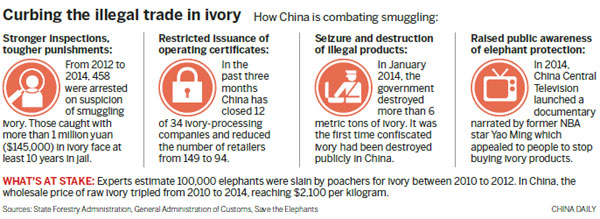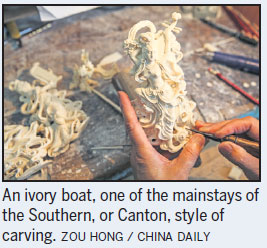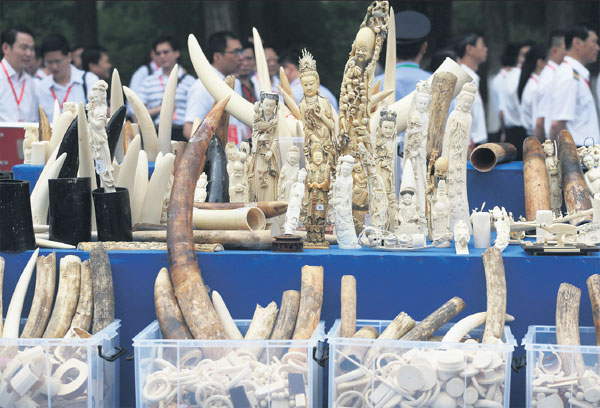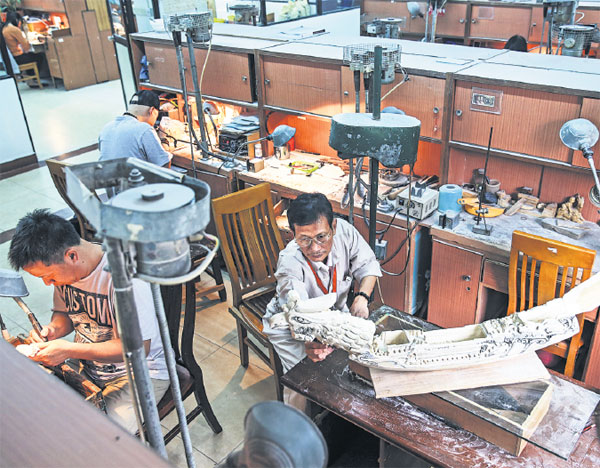Ivory carvers want craft preserved
All commercial processing, trading to be banned by end of year, resulting in job losses and the death of ancient expertise
In recent weeks, Weng Zhanxuan has faced a dilemma as he struggled to make a decision between his future and his family's traditional trade: making sets of balls in which several rotatable layers are carved from a single piece of ivory.
The 24-year-old artisan's family has been making the balls for about 200 years, and he is the sixth generation to follow in his forefathers' foot-steps. The layered balls and ivory boats made in Guangzhou, his hometown in Guangdong province, represent the pinnacle of the Southern, or Canton, style of ivory carving in which the motifs are intricate, rich in detail and have elegant engravings as the focal points.
|
After years of strictly regulating trade in ivory and destroying illegal items, as police prepare to do in this photo from 2015, China is banning any illegally sourced ivory, sounding a death knell for scores of ivory workshops and retailers. Wang Jing / China Daily |

Both his father and his grandfather are revered as national arts and crafts masters, and although Weng only took up the art five years ago, he can carve a ball 11 centimeters in diameter and containing 33 layers-an achievement that usually takes 10 years of practice.
However, these skills no longer provide carvers with a high standard of living as a result of the significant reduction in the ivory trade since 1981, when China signed the Convention on the International Trade in Endangered Species of Wild Fauna and Flora. In 1989, the convention prohibited ivory sales globally to protect elephants.
In the 1970s, Weng's father earned 80 yuan ($11.60; 10.39 euros, £8.95) a month, almost three times the average income of urban workers at the time.
The father and son's combined monthly wage is no more than 6,000 yuan, lower than the average 7,178 yuan paid to new employees in Guangzhou last year, according to a report by Zhilian Recruitment, one of China's biggest recruitment websites.
As a graduate in mechanical and electrical engineering at a local vocational school, Weng Zhanxuan said most of his classmates now work for vehicle companies and earn 10,000 yuan a month, five times his salary.
"My wage is the lowest in my class. What comforts me is that I did a good job of continuing my family's traditions," he says.
However, his story is likely to have an unhappy ending, because both he and his father may soon lose their jobs at the Guangzhou Daxin Ivory Carving Factory.
Three months ago, the State Forestry Administration, which manages the ivory trade, announced that all commercial ivory processing and trading will be banned at the end of the year.
Last year, China had 34 designated ivory-processing enterprises and 143 designated retail outlets. By the end of March, the administration had closed 12 processors and 55 retailers. The rest will be closed by the end of December.
Three of the Daxin factory's retail outlets have closed, and the workshop where Weng and his father work with 33 other artisans is slated for closure.
"I'm very proud of my family's craftwork and will continue with this career, no matter whether it makes me rich or poor," Weng says. "But the ban on trading means we can no longer live on our skills."
Promotions for animal protection can be seen everywhere in Guangzhou's subway stations and bus stops. Celebrities with stern faces hold signs reading, "Say no to ivory products".
To Weng, the promotion is flawed.
"We work with legal ivory, not tusks from illegally slaughtered animals. Sure, those thousands of elephants should be protected, but what about all the ivory carvers? Doesn't anyone care about the extinction of our art?" he asks.
In the decades following the founding of the People's Republic of China, ivory carving was encouraged as one of the few means of earning foreign currency. The Beijing Ivory Carving Factory was one of the country's largest ivory businesses, and from the 1960s to the 1980s it employed about 800 people.
In those days, crafts were divided into nearly 50 forms, including different types of portraiture, flowers and birds, and intricate decorative pieces, while workers were classified as designers, shapers, carvers, polishers and painters.
Unlike many other forms of craftsmanship, ivory carving takes a long time to learn because of the complicated shapes and the cost of the material, which can be ruined by one slight flaw. Many carvers began learning their trade at a young age.
Zhang Shuzhong, 54, is one of 30 craftsmen still working at the factory. He started learning the skill at age 16, taught by Yang Shijun, who is known as "Flower Master Yang" because of a series of exquisite flower carvings he made in the 1950s.
During the 1960s, the golden age of craftsmanship, the factory recruited new workers every year, but only four or five out of 40 would be chosen as apprentices. "It's not a talent given to many people," Zhang said.
In May 2006, ivory carving was included in the First National List of Intangible Cultural Heritage Conservation, but China's efforts to reduce the industry and put the ivory trade under strict surveillance have seen the number of craftsmen fall significantly in recent years.
Zhang describes the announcement that all domestic ivory trading and processing will be banned as a "life-threatening" change.
He says neither a national ban nor calls for elephant protection are convincing justifications for the end of craftsmanship.
"Elephants die naturally every year. To me, making their tusks into pieces of art is a form of rebirth, a renewal of their lives. Since we've adhered to the international convention and only worked with legal ivory, why is our work still tagged as an art form based on elephant deaths, and facing a death sentence?" he says.
Zhang says some of the factory's retired craftsmen, who have decades of experience and skills that face extinction, have received invitations to continue ivory carving overseas (mostly in Japan).
"Although they would receive much higher salaries, many would not make their artifacts in other countries. These delicate artworks are rooted in China. They are part of our culture and something every Chinese is proud of," he says
Zhou Fei, head of the China program at the wildlife trade watchdog, TRAFFIC, says the ban on the use of ivory is harsh, but necessary: "A total ban is the last resort to discourage local demand for black market ivory and to shut down smugglers' attempts to launder poached tusks in legal markets, even if our main target is the illegal trade, rather than those pieces crafted by masters."
According to the World Wide Fund for Nature, poachers kill 20,000 to 30,000 African elephants for their tusks every year. Asian elephants are also threatened, but on a smaller scale.
While Europe is the primary legal exporter of ivory, the Chinese mainland and the US are two of the biggest markets, along with Thailand, Hong Kong and Japan.
In recent decades, China has taken active measures to fight the illegal trade in ivory. Since 2002, annual monitoring by the Convention on the International Trade in Endangered Species of Wild Fauna and Flora has consistently identified China as the world's leading destination for ivory.
In 2008, a one-time sale approved by the commission saw 62 metric tons of ivory sold to China, and now carvers can work on tusks imported before 1989, when the international trade in ivory was outlawed. In other words, the nation's artisans have worked with legal ivory for the last nine years.
The State Forestry Administration allows just 5 tons of tusks to be used every year, and also administers the market for legal ivory by designating businesses and premises for ivory processing and trade. A certificate must accompany every ivory item, when it is on display and when it is sold.
"Both the Chinese government and the commission believe that the art of carving should be protected and the ivory trade can be strictly controlled through the use of legal tusks," says Zhou, from TRAFFIC. "However, when the regulation came into force, problems emerged."
The 2008 auction and China's adherence to the regulation may have confused the public, according to Zhou. "Lots of people think that ivory can be traded freely in China, and that they can buy ivory products through any channel," he says.
Last year, the WWF and TRAFFIC conducted a survey that revealed that many people didn't understand that only a limited number of retailers are legally entitled to sell ivory products. Many were also unaware that legal ivory products are always accompanied by a certificate, which notes the product's weight, size, shape and registered code.
The survey also found that the certificates are often not offered to the purchasers, and noted that more than 28 percent of retail outlets were suspected of involvement in laundering illegal ivory.
"Retailers show customers a carving with the certificate, but then ask the buyer to leave the certificate with them," Zhou said. "The card is useless to most buyers. If the product is made from ivory, instead of other materials, people seldom care about whether they keep a certificate or not."
This method allows unscrupulous retailers to use one certificate to sell more than one piece of work, usually items made from illegally acquired tusks that look very similar to the photo on the certificate, though not a perfect match.
It is difficult to determine illegally sourced ivory products in the marketplace, which has resulted in a challenging gray area for law enforcement officials, according to Zhou, who says the emerging trend of illegal ivory trading online has produced another challenge to market regulation.
Selling ivory on the internet is illegal, and major websites have banned the practice. Since 2012, TRAFFIC has monitored the trade in endangered species on 31 domestic e-commerce and antique or collectables websites, tracking nine wildlife products. Ivory products accounted for more than 50 percent of identified ads.
The program shows that ads for illegal wildlife products on monitored sites fell from about 40,000 posts a month in 2012 to fewer than 10,000 last year.
Nevertheless, it is easy to find dozens of photos of ivory pieces for sale on sites specializing in auctions, antiques and collectables. Moreover, further investigation showed that illegal traders are shifting to a private platform, WeChat, China's most popular social media platform.
With restricted visitor access, anonymous exchanges and the advantages of solitary payment features, WeChat has attracted many illegal dealers who previously operated through traditional websites, according to Zhou.
"Most ivory products sold online are not artworks, but factory-processed ivory beads, chopsticks, Buddhist pendants and bracelets without carvings. Most are made from smuggled tusks. They are our targets, and they account for the majority of the ivory products on the market," he says.
The ban should result in the end of the sale of ivory in the physical market and via channels such as the internet by the end the year.
To protect ivory carving as an intangible cultural heritage, the State Forestry Administration is encouraging carvers to use their skills on other materials, and also invited some to keep their craft alive via written, audio and video records.
The Ministry of Culture will also help ivory sector employees to find other jobs: for example, by encouraging "master carvers" to work in museums repairing and maintaining significant works of art made from ivory.
"We haven't received any further enforcement notices from either the ministry or the administration. To be honest, as a businessman, it's not a big deal to shut down an old factory with just 30 employees," says Guo Jianhuan, president of Guangzhou United Enterprises Development Corp, which now manages the Guangzhou Daxin Ivory Carving Factory.
"But still, I hope the craft can be protected by the government as a cultural heritage, not by selling the works, but simply by allowing a few people to learn and perform the skills as an art form," he says.
Xiao Guangyi, chairman of the Beijing Ivory Carving Factory, says China's legal ivory market has a long history, which will make it difficult to enforce an immediate total ban and simply shut down all related enterprises.
"The simplest way would be for the State to purchase the entire stockpile of legal ivory and pass it on to museums or a few designated workshops for the masters. The commercial ivory trade would no longer be allowed, but artworks could still be exhibited in museums and the carvers' skills could still be passed on," he says.
yangwanli@chinadaily.com.cn
|
Craftsmen carve ivory at the factory. Zou Hong / China Daily |
History of uniquely Chinese art form stretches back thousands of years
Ivory carving is one of the unique charms of Chinese carving, and has a history of thousands of years. The heyday occurred during the Qing Dynasty (1644-1911).
The craft gradually focused on small objects, which produced many of the best examples of the genre.
Most of the pieces are treasures of appreciation and ornamentation. They are decorated with scenes from scholarly stories, flower-and-bird patterns and auspicious subjects related to cultural tastes.
The carvings were highly favored by scholar-bureaucrats, officials and aristocrats.
The artworks handed down from ancient China surpass all others in the international market, mainly because of their delicate carving and the value of the ivory itself.

Academically, Qing-era ivory carvings are categorized into two schools; the Northern style, based in Beijing, and the Southern style, based in Canton, which is now Guangdong province.
The imperial workshops of the 18th century were the birthplaces of typical Northern works, which assimilated a variety of styles and also incorporated the Canton style of carving.
Under the patronage of the emperor and dictated by his taste, court artisans created a unique style of carving that highlighted the ivory's natural attributes and stressed polished textural effects.
The designs were a good mix of elaboration and restraint. Whiile simple designs were intended, the object was to achieve the smoothest possible grinding and polishing.
Typical Northern pieces featured the Buddha, royal servants, religious figures and flowers. The Canton style focused on the proficiency of the workmen, who bleached their ivory white.
From the 17th century, the trade between East and West became increasingly prosperous. Situated on the coast of South China, Guangzhou in Guangdong was a major port for foreign traders.
The style's craftsmanship is unequalled and distinctive, especially motifs featuring layered concentric balls, ivory boats and microcarving.
The record number of layers inside an ivory ball of 13 centimeters in diameter is 57. The layers, which all rotate, are covered with delicate hollow patterns.
Ivory boats were usually carved from a single tusk and were famous for the microcarvings that adorned them. Some featured 500 to 600 carved figures about 1.5 centimeters in height and all with different clothing and hairstyles.
Source: the China arts and crafts association Guangdong folk art museum
(China Daily Africa Weekly 05/26/2017 page20)


















